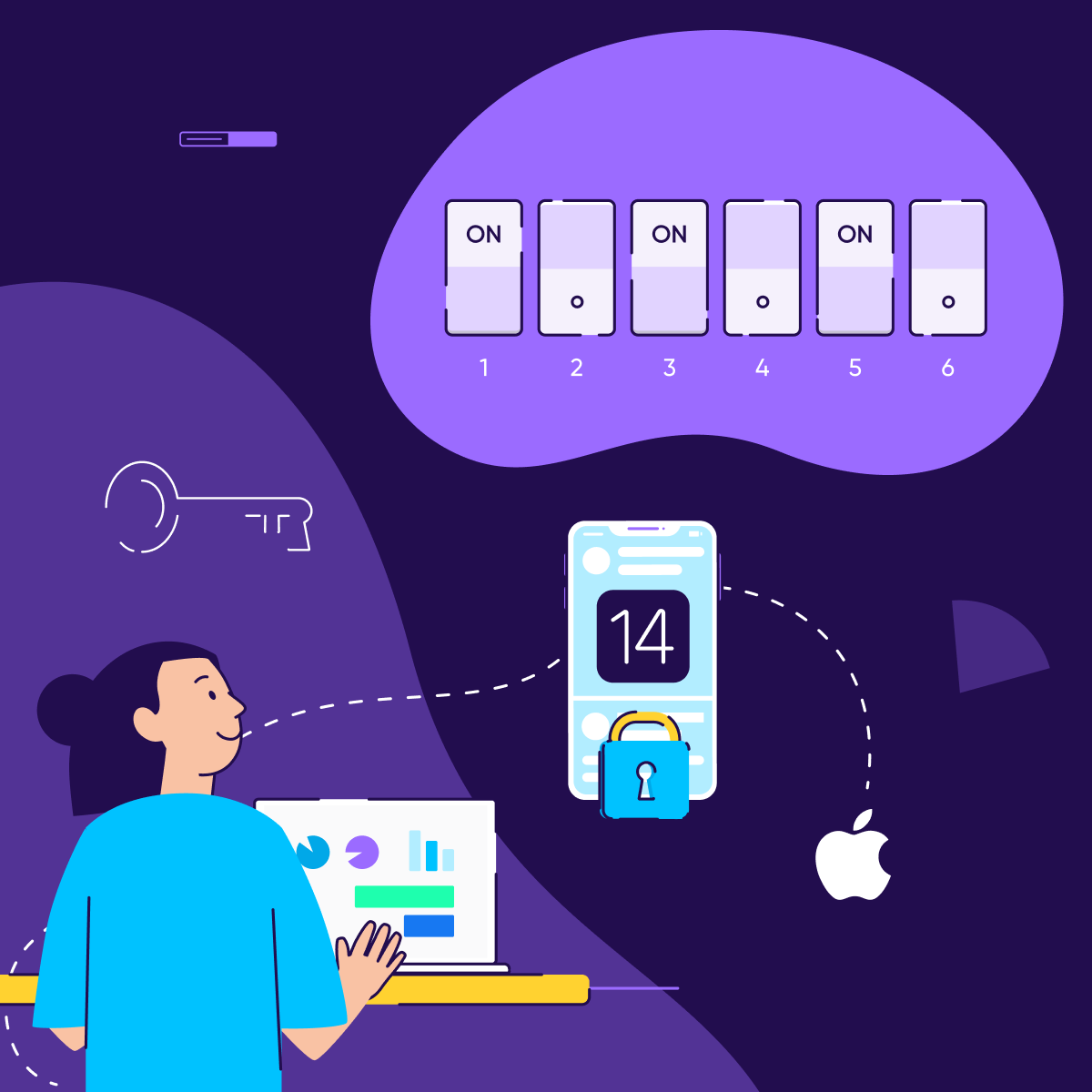
Unlocking the power of SKAdNetwork’s conversion values to measure and predict campaign value

SKAdNetwork – Apple’s privacy-centric solution for deterministic attribution in iOS 14 — brings limitations, complexities, and restrictions compared to previous methods of attribution.
Fortunately, there are ways to navigate these challenges to largely retain the ability to measure and predict the value of your acquired users.
The key to unlocking value from SKAdNetwork is to understand Apple’s unique conversion value mechanism. In this post, we’ll dive deep into conversion values – what they are, the bits that they’re composed of, and how to make them work for you.
What are bits and how do they work?
Conversion values are configured by the app developers to measure post-install activity and tie it back to the install.
*For DE subtitle scroll down
A single conversion value is included in the one-time postback that iOS sends to the ad network. As a result, the information in this conversion value is all the information you can get on a user’s post-install activity (only if they did not consent to ‘tracking’), making it extremely important.
But what does that configuration actually look like, and how can it be customized to provide meaningful insights?
This is where bits come in. A conversion value is defined by 6 bits, which are binary measures – meaning they can be turned on or off (0 or 1). Think of it as a light switch.

This opens up the potential for a variety of measurement combinations within those 6 bits – 64, in fact, from 0 to 63.

Although 64 options can be considered limited, there are still plenty of options to work with to measure revenue, engagement, funnel progress, gender, device, and more.
These values can be used in any way you want – they’re yours to control and assign to the KPIs that are most valuable to you. As long as you properly mapped your conversion values based on your internal logic.
The 6 values, each with its own unique decoding configured by the app developer/advertiser, are then attributed to the source of the install, enabling campaign measurement and optimization.
Optimizing bits to measure value
Mastering this method of measurement is the key to overcoming the limitations of SKAdNetwork and unlocking its potential.
With your 6 bits, you still have the scope to measure early signals of engagement, retention and monetization, and construct a picture of a user’s predicted lifetime value (pLTV) from those signals.
To do so, you must define your bit assignment strategy: what are the events that matter most to your own LTV calculations? From there, you can map those events onto the corresponding conversion values.
You have plenty of flexibility as to how to make best use of your 6 bits to achieve this goal. We can broadly define these in three categories – flat, split, and combo-split.
1. Flat
With this method, all 6 bits are used to measure a single KPI. In the example shown below, the app developer has devoted all 6 bits towards measuring revenue.
The bits here show a specific binary value of 110001, which then returns a corresponding conversion value that informs the app that the user has generated a specific amount of revenue – in this case $49 (see table above).

2. Split
Instead of devoting all 6 bits to a single KPI, split up the bits to measure multiple aspects of user behavior within the same conversion value. For instance, you could devote three bits to measuring revenue, and three to measuring game progress – enabling you to tie these measures together for individual users.

In this example of splitting, the app configured their conversion values based on the following logic:

The conversion value 46 means that the user has spent more than $20 while playing 25 levels.
3. Combo-split
The final category turns up the complexity another notch: combo-split. It takes the split method (in this example, revenue and game progress) and adds a final deterministic on/off signal via one of the remaining bits (e.g. whether the user was logged-in or not).

Using conversion values for predictive analytics
We’ve looked at some of the structural details around conversion values – now let’s talk about why this matters so much for predictive analytics.
We mentioned above how conversion values are mostly based on signals early in the funnel of the user journey, as that is the nature of SKAdNetwork. On top of that, SKAdNetwork’s limitations (such as sending only 1 postback, and that without a timestamp) greatly impact your ability to cohort users and predict their value.
Consequently, building effective predictive models to unlock the power of those early signals is more important than ever.
Advanced marketers have had such models in place long before the arrival of SKAdNetwork, allowing them to predict user value early in the process and optimize quickly.
Now, with only the early signals provided by SKAdNetwork, predictive modeling is all but a must-have for marketers.
Predictions before and after SKAdNetwork
As each app has its own unique way of calculating user LTV – composed of its own range of in-app events, benchmarks and weighting – predictive modeling even before SKAdNetwork required machine training on historical data measured via the MMP’s SDK, followed by a scoring mechanism based on the completed in-app events. In the example below, the deeper the action in the funnel, the greater the weight given in the LTV prediction.

With SKAdNetwork, an additional step is needed.
Once the machine training period and event value configuration have taken place, you’ll need to determine your bit tactics to make sure they capture the event values and combinations that constitute a valuable user.

SKAdNetwork has made it a necessity for developers and advertisers to have a sophisticated prediction model built on these conversion values. Predictive analytics enables you to take user activity during their initial couple of days with the app, and correlate it with their long-term LTV.
Of course, this has a huge range of benefits: you can cut your losses early in the event of high-risk activity, or alternatively identify potential success out of the gate and double down on it. It drastically reduces any wasteful learning periods and lets you take action.
The flexibility of conversion values – and the fact that you have control over them – give you solid tools for predicting future value and optimizing accordingly.
Taking control of conversion values
Understanding conversion values and making them work for you are crucial to unlocking the value of SKAdNetwork. That said, we won’t pretend this is an easy feat – especially if you want to deliver high-performing campaigns.
As an advertiser or developer, control over conversion values is in your hands. However, there are a whole range of challenges to overcome – and that’s why you should make sure only a single entity is controlling this field on your behalf. MMPs are the best choice.
MMPs are not only a trusted, unbiased source: they provide extensive ad network integrations. Ultimately, SKAdNetwork doesn’t exist in a vacuum, and enrichment with other attribution models can greatly enhance campaign optimization.
In terms of technical resources, MMPs also provide seamless client/server SK sync, scale-driven machine learning, and extensive engineering support to help you stay future proofed for later versions of SKAdNetwork.
Key takeaways
Although iOS 14 and SKAdNetwork mark a major shift in the mobile marketing landscape, it is still possible to navigate those changes without compromising much on measurability or your ability to predict user LTV.
Remember:
- Although the 6 bits that make up conversion values can seem restrictive, an effective bit strategy gives scope for advanced measuring.
- With the limitations of SKAdNetwork, predictive modeling is now a must-have for marketers.
- MMPs can greatly aid your ability to deliver high-performing campaigns, and there is immense value in allowing them to control your conversion values.




